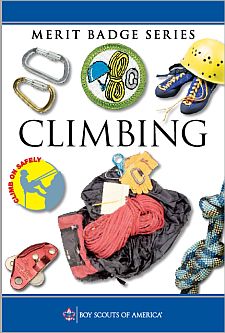- Do the following:
- Show that you know first aid for and how to prevent injuries or illnesses that could occur during climbing activities, including heat and cold reactions, dehydration, stopped breathing, sprains, abrasions, fractures, rope burns, blisters, snakebite, and insect bites or stings.
- Identify the conditions that must exist before performing CPR on a person.
- Learn the Leave No Trace principles and Outdoor Code, and explain what they mean.
- Present yourself properly dressed for belaying, climbing, and rappelling (i.e., appropriate clothing, footwear, and a helmet; rappellers and belayers must also wear gloves).
- Location. Do the following:
- Explain how the difficulty of climbs is classified, and apply classifications to the rock faces or walls where you will demonstrate your climbing skills.
- Explain the following: top-rope climbing, lead climbing, and bouldering.
- Evaluate the safety of a particular climbing area. Consider weather, visibility, the condition of the climbing surface, and any other environmental hazards.
- Determine how to summon aid to the climbing area in case of an emergency.
- Verbal signals. Explain the importance of using verbal signals during every climb and rappel, and while bouldering. With the help of the merit badge counselor or another Scout, demonstrate the verbal signals used by each of the following:
- Climbers
- Rappellers
- Belayers
- Boulderers and their spotters
- Rope. Do the following:
- Describe the kinds of rope acceptable for use in climbing and rappelling.
- Show how to examine a rope for signs of wear or damage.
- Discuss ways to prevent a rope from being damaged.
- Explain when and how a rope should be retired.
- Properly coil a rope.
- Knots. Demonstrate the ability to tie each of the following knots. Give at least one example of how each knot is used in belaying, climbing, or rappelling.
- Figure eight on a bight
- Figure eight follow-through
- Water knot
- Double fisherman's knot (grapevine knot)
- Safety knot
- Harnesses. Correctly put on at least ONE of the following:
- Commercially made climbing harness
- Tied harness
- Belaying. Do the following:
- Explain the importance of belaying climbers and rappellers and when it is necessary.
- Belay three different climbers ascending a rock face or climbing wall.
- Belay three different rappellers descending a rock face or climbing wall using a top rope.
- Climbing. Do the following:
- Show the correct way to tie into a belay rope.
- Climb at least three different routes on a rock face or climbing wall, demonstrating good technique and using verbal signals with a belayer.
- Rappelling. Do the following:
- Using a carabiner and a rappel device, secure your climbing harness to a rappel rope.
- Tie into a belay rope set up to protect rappellers.
- Rappel down three different rock faces or three rappel routes on a climbing wall. Use verbal signals to communicate with a belayer, and demonstrate good rappelling technique.
- Demonstrate ways to store rope, hardware, and other gear used for climbing, rappelling, and belaying.
BSA Advancement ID#:
133
Requirements last updated in:
2007
Pamphlet Stock Number:
35873
Pamphlet Revision Date:
2006
| Worksheets for use in working on these requirements: | Prepared by Craig Lincoln |
Format | |
|---|---|---|---|
| Word Format | PDF Format | ||
Page updated on: May 08, 2022









